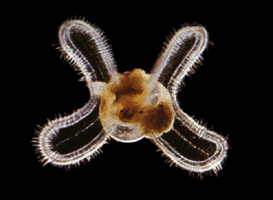|

Gastropod Main

Glossary

References

Links

Hooper Main |
Morphology 2

|
Figure 8. A veliger larva of a marine gastropod. The 'wings' it uses to swim with develop into the snail's foot later on. |
Gastropods amongst all molluscs are characterised by torsion - a 180° rotation of organs during the larval stages from a posterior to anterior position about the head. Fig. 9 also illustrates the major internal parts of a generalised gastropod. In most marine and freshwater gastropods, the planktonic larval trocophores turn into small thin-shelled swimming veligers, which may retreat into their shells because of torsion of their organs. The final stage of aqueous gastropod growth is the familiar adult snail or slug form most often seen.

Figure 9. The gastropoda are differentiated from other molluscs partly because of torsion - a 180 degree roation of organs about the head. Note the posterior position of gills in the cephalopod (typical of molluscs) and the ancestral mollusc, as compared with the their anterior positioning in the gastropod.

|

|

|

|

|

